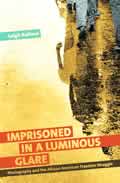Prof traces role of photography in black freedom struggle
Photographs of the murder by lynching of African-American men, women and children were routinely taken and often made into postcards as mementos by racist whites during the Jim Crow era.
Less well known is that they were also collected and circulated by African-Americans and civil rights activists to incite indignation at the spectacle of racist mob rule and to mobilize for social change. Those horrific pictures were thus transformed from weapons of terror into instruments of social protest and galvanized generations of anti-lynching and civil rights activists.
Photography may have started out in the hands of white supremacists, but the images it generated and ultimately the media itself was appropriated in turn by African Americans as a powerful tool in the struggle for self-determination.

In her recently published book, Imprisoned in a Luminous Glare: Photography and the African American Freedom Struggle(2011, University of North Carolina Press), Raiford provides a history of African American political ownership of photography as both practitioners and objects. She explores this history from its beginning.
“So much of the long African American freedom struggle is about effecting public opinion and changing the way we understand black bodies and black rights,” says Leigh Raiford, professor of African American Studies.
Already in the nineteenth century, black activists like Sojourner Truth earned income by selling photos of herself at lectures. Frederick Douglass wrote of the power of photography to communicate accurate images of black life. But it was the generation of post-WWII activist groups—including the Black Panthers and the Student Nonviolent Coordinating Committee (SNCC)—that made the broadest use of photographic technology as an instrument of social transformation.
“What I saw happening over the course of later periods is that social movements started to seek out, train and employ photographers,” Raiford says. “SNCC’s control of its own media is vital to the movement itself.”
This post-war generation came of age with the birth of television. They were exposed to the magazines Ebony and Jet, including the shocking 1955 photograph of the body of a lynched boy, Emmett Till, in an open casket, published in Jet with the permission of the boy’s mother.
“That image led to a public political mourning that many civil rights activists point to as a galvanizing moment,” Raiford says.
African Americans recognized the power of the visual image and used it in both personal and public contexts. While mainstream news outlets began to cover the civil rights movement once police attacks on protests could no longer be ignored, SNCC photographers were embedded in political events from early on. SNCC created a communications wing as well as a photo and film agency within its organization. Their photographers produced publicity material, press releases, album covers, poster and pamphlets.
“These were young folks who were already immersed in the technology of the moment, not unlike the activists of today,” says Raiford. “Photography was a technical tool among many tools. It was another weapon in the arsenal.
By 1963, photos of non-violent black demonstrators enduring attacks by fire hoses and dogs appeared daily in newspapers across the country. The violence provoked by the post-war movement for racial equality in the American south was revealed by African-American photographers for all to see, with perpetrators “imprisoned in a luminous glare,” in the words of Martin Luther King, Jr.
Raiford’s book includes an analysis of how the uses of photography evolved with of the emergence of the black power movement out of civil rights. Images of interracial cooperation were supplanted with representations of the assertion of power and control by African Americans and most notable the Black Panthers.
In working on this study, Raiford interviewed photographers, many of whom had never been interviewed before about their photographic work and their artistic ambitions. Civil rights photographs were produced not only by African American, but also white, Asian American and Latino photographers who picked up their cameras as a way to participate in the movement of their day. Some of these photo-activists went on to pursue careers as art photographers while others continued to work on social issues.
“They signed up to be part of this revolution,” Raiford says. “A camera was the tool they took up.”